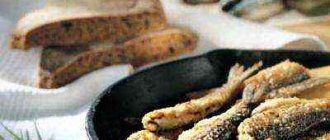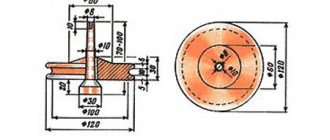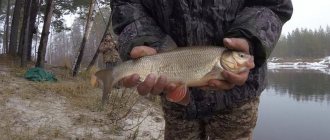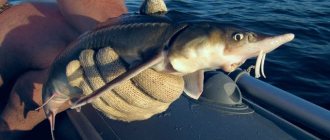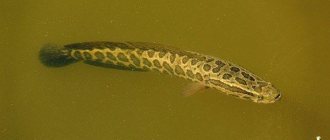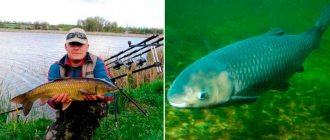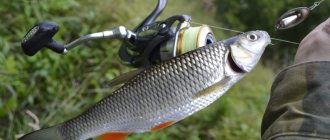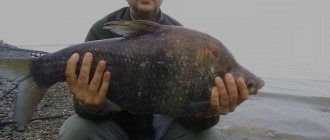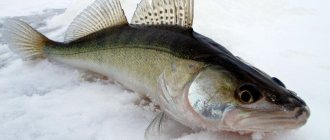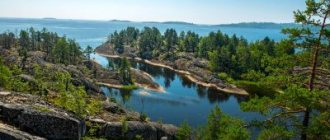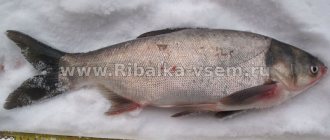Description
Vendace (or ripus, or kilets) belongs to a species of freshwater fish of the whitefish family.
Due to its nutritional properties, in the 15th - 17th centuries it was considered royal food and was included in the daily menu of crowned heads (it was called royal herring). There are 4 subspecies:
- European,
- Siberian,
- Belomorskaya,
- Pereslavskaya
The body of this fish is strongly compressed on both sides, so it is often confused with herring. In individuals living in seas and lakes, numerous modifications are observed in external characteristics: size, body color, number of scales.
For example, if we take two different lakes, each of them will be dominated by its own individual, it will be almost impossible to find the same vendace.
This is not a very large fish: the lake form (ripus) reaches up to 45 cm and weighs up to 1 kg - this is the Siberian vendace. On average, the length is 10 - 12 cm, and the maximum weight is 75-100 g. The life cycle lasts about 7 years.
How do you catch vendace?
Vendace has a slender herring-like body. It has a relatively small cone-shaped head and a sharp snout. The scales of vendace are larger than those of salmon. In addition, she has large, beautifully shaped eyes. The vertical section of the narrow mouth is directed upward along the oblique. Her lower jaw protrudes slightly forward. The color of the vendace's back can be dark, gray, blue or greenish with a tint. The side and belly are silvery. You can't help but notice her fins. Their contours seem to be outlined with a marker. The average length of the fish caught is from 15 to 30 cm. Occasionally, individuals up to 45 cm are found.
The natural habitat of vendace is quite extensive. It lives in England, Scotland, and southeastern Norway. In Russia, this fish is found in its northwestern part (Baltic, Upper Volga, etc.). Thanks to recent acclimatization, it can now be found in southern Russia, as well as in Bavaria and France. In the lakes of Sweden and northern Russia, up to Siberia, a closely related species of vendace, C. baunti, is widespread.
The fish that live in lakes live in schools. The basis of its diet is practically limited to cladocerans and small cyclops. To lay eggs during the spawning period, she tries to find a sloping shore with a sandy or pebble bottom. In the Baltic countries, vendace is considered an anadromous fish. Here, during the spawning period, which runs from September to early December, it rises upstream of rivers flowing into lakes, where it simply attaches its sticky eggs to pebbles and stones lying at the bottom.
Here it can be found without any problems on extensive pebble shallows, at depths of 2 to 4 meters. You should not look for fish in the rapids. She doesn't love her. For the most part, flocks of vendace are found in areas where the river current twists or simply significantly loses its speed.
The vendace fishing season begins at the end of winter, after the last ice. During winter fishing, the best bait for catching it is a chironomid larva. As artificial baits, the most catchy ones are considered to be: from light jigs - “cone”, from ordinary ones - “droplet” and “diamond”. The latter is tied with red or brown woolen thread, and the hook is baited with bloodworms or a piece of fresh white fish.
Of the spinners, the most catchy are the vertical, oblong models, equipped with double or triple hooks attached to the winding ring. Their maximum dimensions should not exceed 70 by 10 mm. The bait used is bloodworms, as well as a piece of worm or fresh white fish. During fishing, the spoon is sharply raised by 40-50 cm, each time holding the bait for 3-5 seconds.
Used for catching vendace and bait. To do this, a special feeder is filled to capacity with crushed meat of mollusks or various crustaceans.
When it comes to summer gear for catching vendace, a lightweight 4.5-meter telescopic rod equipped with a spinning reel is used. The use of sliding equipment will make it possible to make long casts. Of the hooks, No. 4, which has a long shank, is most suitable.
The vendace bite is characterized by sharpness. It is very reminiscent of the rudd bite. The float or nod first begins to tremble slightly, after which it sharply goes under the water.
Fishing for caught fish does not cause any difficulties. The main task in this case is not to scare away the gathered flock.
Happy fishing!
Habitats
The habitat of this fish is relatively wide, in almost all the larger lakes of northern Europe, in the Gulf of Bothnia and the Gulf of Finland. In our country it is numerous in the lakes of the Kola Peninsula and Karelia, the Baltic Sea, up to the Arctic Circle. To the south - everywhere - to lakes Beloe, Seliger, Pleshcheyevo, Veslug. Occasionally found in the Saratov Reservoir.
Along with all whitefish, vendace is a bottom-dwelling fish that prefers reservoirs with cold, oxygenated water and a sandy or muddy bottom.
vendace
Vendace is a fish from the whitefish family.
At the beginning of the last century it was actively mined. Gradually, the population decreased, and some of its species even had to be listed in the Red Book. Fishermen value it not only for its taste, but also for the exciting process of fishing. Object category (river, mountain system, forest, etc.): fish Place: Republic of Karelia Additionally: size from 15 to 30 cm
Description Edit
The fish is not a large species. Typically, individuals are found about 20 cm long, with a maximum of up to 30 cm. The average lifespan of fish is from 7 to 12 years. The individual gains a weight of 200 g by the age of 6 years. Catching a specimen weighing 350-400 g is considered lucky.
Because of its resemblance to herring, vendace used to have the popular name “royal herring.” There are several species of it found on the territory of Russia:
· European;
· Siberian;
· Belomorskaya;
· Pereslavskaya.
The body of the fish is herring-shaped, slightly flattened laterally. The back, shimmering blue or green, is darker than the convex belly. The fins have a border. A sign that vendace is a whitefish is the presence of another fin, an adipose fin, between the caudal and dorsal fins.
The head of the fish has the shape of a cone, the lower jaw is slightly pushed forward.
Section No. 2 Edit
Vendace loves lakes with clean water. It is found in water bodies of the White, Baltic, and Barents seas. In Karelia it is caught in Lakes Ladoga and Onega. In the r. The Pechora and its tributaries intersect European and Siberian species of vendace. The habitat of the European species from the south is limited to Lake Peipus and deep lakes in the upper reaches of the Volga. In recent years, the fish has begun to be found further south - in the Saratov Reservoir and lakes of Belarus.
The number of individuals of large species of vendace is decreasing, so they are under state protection. Fishing is prohibited during the spawning period, which begins in late September to mid-November and lasts until December.
How to catch Edit
In the summer, vendace is caught from a boat and from the shore. Fishing from the shore is carried out using bottom tackle, a fly rod or a Bolognese rod. From a boat, vendace is caught using a side fishing rod with a nod. If it comes across a fishing rod with a float, it is by accident.
In winter, getting vendace is more exciting. Using the ice method, fish are caught using a garland, a jig and a hook. In this case, it is necessary to give a firm nod. The bite begins at a depth of more than 20 m. Therefore, fishermen put tents on the ice to protect themselves from the wind. Experienced people who know the habitats of fish set up real houses to fish in comfort.
Ripus Edit
Rhipus is a subspecies of European vendace. Initially it was found in Lake Ladoga and Onega, then moved to Lake Peipsi, Seliger and other reservoirs of Karelia. In the 30s last century, the fish was released into the Ural lakes, where it took root well.
Rhipus grows 2 times faster, reaching 300 grams in weight by three years. The body length of some individuals is more than 45 cm, weight – up to 1.5 kg.
Schools of ripus live in cool, clean and calm water. As their habitat, they choose coastal areas of reservoirs 3-5 m deep with a rocky bottom.
Sexual maturity of fish occurs at the age of 3-4 years. The ripus goes to spawn in November–December, going to shallower places with a depth of 1.5–3 m with a sandy and pebble bottom. The female produces about 3,000 yellowish eggs, which she does not bury in the ground, but leaves at the bottom. Caviar develops at the bottom for 140−160 days.
The diet of the ripus consists of zooplankton, crustaceans and fry.
Rhipus is valued for its tasty meat, rich in fatty acids and other beneficial substances. Therefore, along with the extraction of “wild” fish, its breeding is becoming popular. It has been observed that vendace and ripus quickly adapt to life in ponds. Therefore, ripus are often grown until the age of fry, and then released into natural reservoirs.
Fried vendace. Photo: pixabay.com
Fishing methods
Of all the methods for catching vendace, these are winter fishing rods such as balalaika and filly and a net (mesh from 10 to 25, depending on the size of the fish in a given reservoir).
With a winter fishing rod they catch vendace exclusively with small jigs (garland tackle). It is caught with nets during spawning, either in late autumn (October, November) or at the beginning of winter (the nets are placed under the ice).
In conclusion, I recommend watching the video: catching ripus on the wilds in winter. (Uvildy is a lake in the Chelyabinsk region.)
0
Author of the publication
offline 7 years
Fishing for vendace
Vendace is a small freshwater fish. It belongs to the salmon family and the whitefish genus, with some representatives of other species of which it sometimes interbreeds. Despite its modest size, it is a valuable commercial fish. Depending on its habitat, it is divided into European, Siberian and White Sea vendace. It has many popular names - kilets, herring, saurey, Pereslavl herring, Ob herring, ripus, herring.
In appearance it looks like a herring or bleak. Her body is elongated, strongly compressed from the sides. The upper jaw is much shorter than the lower jaw; the thickening on the upper jaw extends into the notch of the lower jaw, as in all whitefish. The scales are quite large for such a small fish, silvery, the back is dark, the belly is light, the caudal and upper fins are gray, the lower fins are light.
The vendace is a small fish, but it can grow to gigantic sizes (for a vendace, of course), and reach thirty-five centimeters in length with a body weight of almost a kilogram. Of course, this is the exception and not the rule; usually at the time of catch the vendace is a little more than ten centimeters long and weighs one hundred grams. The lifespan of vendace is no more than fifteen years. Vendace is a cold-loving fish.
Found mainly in the north, in cold northern waters from Norway to Eastern Siberia and from the Arctic Circle to the Volga. Most of all, vendace loves lakes like Ladoga, Onega, Pleshcheevo, Chudskoye, but is found in rivers and bays of the northern seas. In small reservoirs with water that gets too hot in the summer, vendace does not settle. She loves clean, cool or cold water, maximally saturated with oxygen.
Vendace is a bottom-dwelling and schooling fish that loves depth. The ideal habitat for vendace is holes at a fairly decent depth. The vendace prefers a sandy or clayey bottom, clean, not silted, with underwater rocks and holes. Vendace does not like strong currents; it prefers slow or medium ones. Forms large flocks that feed, rising to the surface of the water and are always accompanied by predators that feed on them - seagulls and fish.
Read! Choosing a slotted spoon for winter fishing
The diet of vendace is modest - plankton, larvae, worms, crustaceans, insects, mollusks. If the size allows, then the vendace enjoys feasting on the fry.
Vendace is extremely popular among local residents, who catch it all year round and enjoy eating it in a variety of forms. The vendace fishing season opens in September and ends in May. The main thing is to get on the joint. Since vendace is a small fish, the tackle should be appropriate - light and sensitive.
Vendace is caught all winter at a depth of five to twenty meters. The gear used is a jig, a garland or a hook. Bait - live bait, burdock, bloodworms or a sandwich of them. Complementary feeding is required. Complementary food can be any universal food for small fish made from dried daphnia; you can add wet fine sand, milk powder or egg white to it. For more comfortable fishing, tents are usually placed over the holes.
In spring, summer and autumn you can catch it both by boat and from the shore. An onboard fishing rod with a nod is used when fishing from a boat, while donkeys, Bolognese or fly rods are used when fishing from the shore. It is better to use animal bait - live bait, leech, larva, worm, crustacean, fly or nymph. In summer, vendace is hot, it is passive, and can still be caught.
Vendace is a royal fish; it was always included in both the daily and festive menus of Russian tsars. The famous Karelian dish - kevyatkala - is most delicious made from vendace, although not everyone will appreciate it. Currently, Pereslavl-Zalessky has an image of smoked vendace on its coat of arms.
Description and lifestyle of vendace
Vendace (ripus) is the smallest representative of the European whitefish. The length rarely exceeds 12-20 cm and weight 200 g. Moreover, this fish reaches similar sizes by 6 years. In total, vendace can live 7-12 years.
This lake freshwater fish is somewhat reminiscent of herring. It is also laterally compressed, has a completely flat back and a convex abdomen. Due to its external similarity to herring, it is often called “herring”, and in the northern regions – “herring”.
The lower jaw of the vendace is longer and overlaps the upper. The scales of this representative of the noble whitefish family are quite large, gray-blue on the back, almost white on the belly, and silvery on the sides.
Where is vendace found?
It belongs to the cold-loving freshwater species; it can be found in rivers and sea bays near the Arctic Ocean, in areas from Alaska to the White Sea. The Siberian (Yenisei) and White Sea varieties are smaller than the European vendace. Although ripus is considered a river fish, it enters desalinated parts of the seas, and therefore is considered semi-anadromous.
It tries to stay in quiet waters near the coastal zone at a depth of 3-5 m. The main diet is small smelt and zooplankton. Rhipus becomes capable of fertilization at 3-4 years of age. Vendace spawning occurs at depths of 1-1.5 m in December-November. Fry from small yellow eggs are born after 14-16 days.
Like any fish, ripus can contain dangerous parasites; it must be subjected to long-term processing. The most dangerous are flatworms that cause opisthorchiasis. In the northern rivers there are also fluke, the causative agent of clonorchiasis, broad tapeworm, nanophyetosis worm and others.
How to distinguish smelt from vendace
Smelt (silverfish) is somewhat similar in appearance to vendace. However, the latter has characteristic spines on its back, which the smelt does not have.
We also pay attention to the smell. Smelt has a characteristic pleasant aroma of fresh cucumbers.
Commercial and amateur fishing for vendace
Rhipus with tasty and fatty meat is a valuable commercial fish. Siberian vendace is considered the healthiest and most delicious. It is mined in rivers near the Laptev Sea. In the north of Russia and, in particular, in the Urals, where significant quantities are caught, it is considered the main nurse. In the Chelyabinsk region, ripus is grown artificially on special farms.
Extraction is carried out using seines. The largest quantity of vendace is caught on Lake Onega. There, for these purposes, they use gear in the form of an unequal-winged net called a kerevod. In the Pereyaslavl area, long residues are also used - a net of motny and a pair of wings. In Karelia they fish on Lake Ladoga with ordinary nets.
Recreational fishing is allowed in certain places and at certain times. Rhipus, listed in the Red Book, is classified as an endangered fish species. But amateur fishing with nets is allowed; it is prohibited during the spawning season. The cell size for this small fish is 10-25 mm.
You can also catch it using float or bottom tackle with hooks or jigs. Rods with “running” equipment are also convenient. For complementary feeding, worms, bloodworms, and mollusks are used.
Catching vendace in winter
For winter, special fishing rods such as a filly (a device on stands without a reel) or a balalaika, in which the reel is moved to the handle, are convenient. Hooks are replaced with small jigs in garlands.
Where do they catch vendace in winter?
You can find it at this time at a depth of 20-30 m, although it also goes out to feed at a depth of 7-10 meters. A good bite is guaranteed on cloudy days and during snowstorms.
